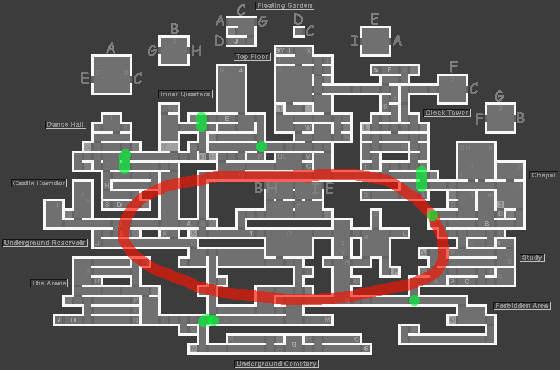Aria of Sorrow Review – Centralised Layout and The Tactical Soul System
November 5th, 2010
Aria of Sorrow is a fine improvement over Harmony of Dissonance. I razzed on Harmony of Dissonance for its incompetence at stringing the player from one major interval of gameplay to another. In regards to Aria of Sorrow, you never once stop to think about the layout and you don’t really use the map screen all that much either. You’re too busy whisking off to the next place on the map. Each subsection exit is the closest offshoot route to the entrance of the next which means that there’s minimal backtracking. Furthermore I didn’t feel the need to use a teleport once, whereas I used them more frequently in Harmony of Dissonance.
How is Aria of Sorrow such a dramatic improvement? Well let’s take a look at the castle layout.
You can see how each subsection (marked with their squished text titles) connects to a central part (red circle) which the player arrives back, rounding off the chunks of gameplay nicely. You’ll also notice that the subsections themselves are threaded together at various junctions (green dots), allowing for a smooth transition between nearby subsections without negating the overworld hub. This layout means that the player can be strung off to tackle more than one subsection at a time and then return, with minimal fuss, to the central hub and move to the next fresh chunk of gameplay.
What you can’t see on the map, however, is the complete overhaul to the ability system. In Aria of Sorrow there are more significant upgrades this time, including the ability to walk on water, walk underwater, become a bat alongside the regular double jump, high jump and slide mechanics. The former three are all a part of the new Tactical Soul System. These abilities act as devices to draw the player to the entrances of each subsection by interaction points as I described in my Harmony of Dissonance piece. Let’s be a little clearer by using an example though:
When the player begins the game, they explore the central hub area and come across areas that they cannot quite reach or parts of the game they can’t interact with. For the sake of this example, the water level near the entrance to the cemetery makes it impossible to overcome the high wall blocking the player’s path. The player takes a note of this and moves on. Later they will acquire the Undine ability which allows them to walk on water. Receiving this item and playing around with it will likely create a click in the player’s brain, telling them where to go next.
The more abilities, the more opportunities the game has to exploit this technique of letting the player realise their own path. Let’s talk about this Tactical Soul System, shall we? I described it on Twitter like this:
“Soulset [Tactical Soul System] is like the fusion system from Metroid Fusion, however, you can gain abilities from regular enemies instead of just bosses”
So, basically, when the player downs an enemy, there is a chance that they will absorb their soul thereby inheriting the enemy’s ability. There are 3 groups of souls (Bullet, Guardian, and Enchant) and only one soul from each group can be equipped at a time. Bullet souls are sub-weapons, guardian souls are similar to spells and use up magic for the duration of their use and enchant souls boost stats, while some offer temporary abilities (walking on water, for instance). The Tactical Soul System gives the player incentive to actively engage in combat and rewards them with new techniques which feed back into diversifying the combat. I’ve discussed this self-sustaining approach of rewarding players with more tools before in regards to Space Invaders Infinite Gene. In Aria of Sorrow it goes a long way into alleviating the grind that can occur through the mostly spammy combat. It’s a much more fleshed out than the sub-weapon drops plus elemental spell combinations of Harmony of Dissonance. The wide spread of equipable weapons, ranging from your traditional whips to axes, spears and even a pair of guns, is the other element of Aria of Sorrow which livens up the combat.
Conclusion
Aria of Sorrow addresses the castle layout issues of its predecessor Harmony of Dissonance by using a central hub to connect subsections together and avoid messy overlap in design. The core ability set has increased and works more effectively as a device to lead players from one area to another based on interaction points left at subsection entrances on the main hub. The Tactical Soul System, like in Space Invaders Infinity Gene, diversifies play on the players own participation and works effectively at reducing the grind that may come from combat. Overall, Aria of Sorrow is the better of the two games with cleaner castle design and a the Tactical Soul System which encourages the players to participate more with the combat, rewarding them with more tools that inturn make play more varied.
Necessary Aside for stuff that needs to get off my chest:What really irks me about Aria of Sorrow though is that 3 specific souls are required to see the real ending. Argh!
Additional Readings






 Game Design Companion: A Critical Analysis of Wario Land 4 - $7.99
Game Design Companion: A Critical Analysis of Wario Land 4 - $7.99 Level Design: Processes and Experiences
Level Design: Processes and Experiences Speed Boost: The Hidden Secrets Behind Arcade Racing Design - $5.99
Speed Boost: The Hidden Secrets Behind Arcade Racing Design - $5.99 Adventures in Games Analysis: Volume I - $5.99
Adventures in Games Analysis: Volume I - $5.99







